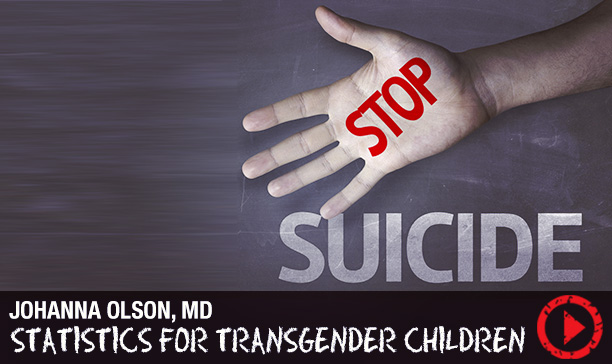Transgender Kids
Having a Transgender Child
The term transgender describes people whose gender expression or identity does not match the sex that they were born with. Gender identity represents a person’s internal understanding of being male or female, while gender expression illustrates how people chose to share their gender identity. For example, gender expression can be shown through clothing, makeup, or certain behaviors. In today’s society transgender or gender-nonconforming identities are constantly changing in terms of how people perceive them and how they perceive themselves.
Under the greater category of transgender, there are many more specific terms that can be used. One of them, for example, is transsexual. Transsexual refers to individuals who find that their gender identity is different from their biological sex. Transsexual people may desire to change their bodies through the usage of hormones or a surgery. Those assigned female but who identify as male are known as transsexual men or female-to-male. On the other hand, those assigned male but identify as female
... Read more
are known as male-to-female. While these terms are pretty comprehensive, still some individuals do not want to be identified as transgender, but rather male or female.
Many people want to know the prevalence or statistics of transgender people in today’s society. However, it is hard to categorize or estimate these numbers because there is such a wide range of sexuality and gender.
Gender Dysorphia and Gender Identity Disorder
Gender dysphoria, previously known as gender identity disorder, is the conflict between the physical sex of a person and the gender that they identify with. Over time, these conflicts can lead to a mental and physical changes in a person. Individuals might feel uncomfortable in their own skin, rejected by their peers, or severely depressed. To be diagnosed with gender dysphoria or a similar condition, experts have come to a couple conclusions. The feeling of being trapped in a body of the wrong gender must last for at least two years and there must be some psychiatric and historic evaluation. There are many ways to help individuals in this situation find comfort in their decisions.
Johanna Olson, MD, the medical director for transyouth at Children’s Hospital Los Angeles offers amazing tips for finding the right professionals to help you and your child. “It’s so important that they get a mental health therapist who provides an affirming model, which means they support that person’s authentic gender, and they help work through all of those challenges, help them face those challenges, and really build what I call a ‘resiliency toolbox.’ This is going to be their kit that they have at the ready for all these really undeniable issues that they are going to face in adolescence,” Johanna Olson says.
Transgeder vs. Gender Nonconforming vs. Gay
As young people grow up and learn more about themselves, they might display or hint to some preferences one way or another. Clinical psychologist and expert Diane Ehrensaft, PhD, uses her professional background to flesh out some of the common misconceptions and concerns that parents might have about their children. “Parents and mental health professionals, alike, are wondering how do I tell the difference if this child is transgender or this child is gender nonconforming, maybe, gender nonconforming on the way to being gay,” she shares. She goes on to describe how language serves as a marker for this. “The transgender children that I work with will typically say to me, ‘I am a girl or boy.’ The gender nonconforming child will typically say, ‘I feel like a girl or boy,’ or sometimes, ‘I wish I was.’ It’s not an exact science, but it usually does separate the two groups.” The transgender group is saying that they identify with a gender that is different than what their birth certificate says, while the gender nonconforming group is saying is more fluid. These are some signs of how kids can use keywords and actions to drop hints about their sexual identity or being transgender.
Options and Solutions
For some individuals, gender re-assignment might be the best option, while for others cross-sex hormones might a better route. Through evaluations and referrals, Johanna Olson describes how individuals can go through the gender re-assignment process. “We find out if that child has been damaged from the response of their authentic gender and that expression kind of see where they are on that road. And then a lot of the medical decision making comes where they are in the developmental process physically", she explains.
The gender reassignment process can be very different for everyone. Some people choose to move forward with a surgery that will help align their gender identity with their physical body parts. Others still identify with a different gender but do not choose to move forward with a surgery.
Another option is cross-sex hormone therapy. Dr. Johanna Olson explains this as, “Cross-sex hormone therapy is the addition of hormones that will induce secondary sexual characteristics of the gender that matches the internal gender. So, in other words, a male-bodied person, who has a female gender identity and would like to bring their body as close to that identity as possible, those young people would get estrogen.” Olson notes that these hormones are actually pretty, affordable and safe for those who choose to take that path. There are some extra steps taken in regards to cross-sex hormones to monitor the individual and make sure that they are responding well to the hormone, rather than developing any unsafe side-effects.
Supporting Transgender Children
One of the most important components of having transgender children is parental support. Expert Johanna Olson recognizes the significance of parents understanding and supporting their child. “They really need to understand that you are born with your gender identity. It’s an immutable characteristic in part of your core being and your gender identity is not a choice.” By sharing this information with parents, Olson is reiterating the importance of parental support.
Psychologist Diane Ehrensaft, PhD, shares one extremely valuable piece of advice. “The first thing is love your child. It’s as easy as that. Make sure you love your child for who your child is telling you he or she is.” After that, Ehrenhaft acknowledges the importance of seeking support whether it be from your community or a professional.
Puberty also marks a difficult stage in an adolescent’s life, especially for transgender youth. Bullying and harassment can be extremely detrimental for these individuals, so support and awareness is always important.
Additional resources:
What Not to Say When Your Child Comes Out as Transgender
https://www.goodtherapy.org/blog/what-not-to-say-when-your-child-comes-out-as-transgender-1117174
Why is LGBT Depression So Prevalent? Here’s How to Help
http://blog.lighthouse.lgbt/depression-lgbtq-community-psychiatric-nurse-practitioner-explains/
The Ultimate Guide to LGBTQ Dating Safety
https://backgroundchecks.org/the-ultimate-guide-to-lgbtq-dating-safety.html
The Parent, Educator & Youth Guide to LGBTQ Cyberbullying
https://www.connectsafely.org/lgbtq/
How to Create an LGBTQ-Friendly Neighborhood
https://www.homeadvisor.com/r/how-to-create-an-lgbtq-friendly-neighborhood/
LGBTQ Comprehensive Guide to Drug Abuse
https://www.amethystrecovery.org/lgbtq-comprehensive-guide-to-drug-abuse-treatment-options/

























































Comments
please dont be mean im trying my best
hush hush im doing this on my own